continuousWave --> Whaler --> Reference
2002 170 MONTAUK
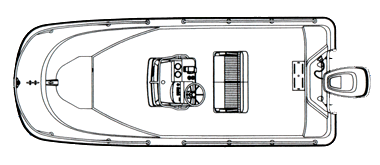
Dimensions & History
DIMENSIONS (from 2002 Specification Sheet)
Length......................17 feet
Beam........................6 feet 10 inches
Draft.......................9 inches (with engine tilted clear of water)
Dead rise at transom........16 degrees
Cockpit Depth...............19 inches
Weight......................1440 pounds dry, no engine
Maximum Weight .............1650 pounds
Swamped Capacity............3400 pounds
Persons Capacity............7 people
Maximum horsepower..........90 HP
Minimum Horsepower..........60 HP
Fuel Capacity...............13.2 gallon (two 6.6 gallon external tanks)
Transom Height..............20 inches
Bridge Clearance............4 feet 7 inches
HISTORY
Designer....................Boston Whaler
First year offered..........2002
Last year offered...........TBA
Color.......................2002 Whaler White
M.S.R.P.....................$ 17,655 Introductory Price which includes
Mercury two-cycle 90-HP ELPTO engine,
E-Z Loader galvanized trailer
Engineering Changes.........Hulls made after 07/12/2002 incorporate
embedded plywood in the transom for the purpose
of reinforcing a mount for an auxillary outboard
engine bracket.
EQUIPMENT
Standard .....DECK/COCKPIT:
Bow locker with fiberglass cover and
overboard drain; Bow and stern lifting eyes;
Welded 316L stainless steel bow rail
and side rails; Heavy-duty rub rail;
8-in stainless steel bow cleat;
molded-in port and starboard boarding steps.
Stern cleats (c.2004)
CONSOLE:
Stainless steel steering wheel; electric
horn; electrical switch panel; welded
316L stainless steel grab rail; acrylic
windshield; access door; binnacle control;
drink holders (2).
SEATING:
Reversible pilot seat with locking backrest.
MECHANICAL:
Teleflex no-feedback steering; classic style
navigation lights; battery box with hold-down
strap in console; Mercury-TM pre-rig;
90 ELPTO Mercury engine; bilge pump with float
switch; 6.6 gallon fuel tanks (2) with hold-
down straps.
GALVANIZED TRAILER E-Z LOADER:
Trailer jack; tie-downs; winch with nylon strap.
Notable options...
Swim platform with hand rail and stainless
steel telescoping ladder ($ 256);
Striping and graphics (red or blue);
60 ELPTO Bigfoot four-cycle Mercury engine ($ 1,122);
90 ELPTO four-cycle Mercury engine ($ 2,308);
Drum brakes and flush kit for trailer ($ 577).
FISHING PACKAGE: ($ 660)
Tackle drawers; compass; 72-quart cooler
seat with cushions and backrest; console
mounted rod holders (4).
COMFORT PACKAGE: ($ 641)
72-quart cooler seat with cushion and backrest;
bow cushion.
CANVAS:
Sun-top with boot (red or blue) and stainless
steel fittings ($ 822);
Gray console cover ( $201);
Gray reversible pilot seat cover ($ 192).
DESCRIPTION
The 170 Montauk was introduced at the Miami Boat show
on February 14, 2002, replacing the classic 17-foot Montauk
model which had been in continuous production since
1976. Accordingly, much of the description that follows
will make reference to the differences between the old
and new models.
Hull
The new Montauk hull is generally the same size as its predecessor,
but has grown slightly. The length has increased five inches
and the beam has increased eight inches. The draft has remained the
same. The cockpit depth remains the same.
The rated capacity is the same, seven persons. The dry hull weight has increased
about 450 pounds. The engine ratings are somewhat unusual.
Because of the growth in hull weight, the minimum horsepower recommendation
has increased to 60-HP from 35-HP. On the other hand,
the maximum horsepower limitation for the new, larger, heavier boat,
has decreased to 90-HP from 100-HP.
The hull departs from the old twin sponson design
and now resembles the 13-Sport in its general lines more than it does
its classic predecessors.
The bow has a chine line suggestive of the old "smirk" trademark of
a Whaler hull, but the depth of the reverse chine is much less.
The hull is more slab sided (actually almost concave at some points),
with the bow chine line sloping down and becoming a very prominent
reverse chine in the aft portion of the hull.
The bow entry is fairly sharp and the traditionally
squarish Whaler bow flares considerably over the central hull.
The hull bottom tapers to a very gentle rounded vee at the transom.
At the rear corners of the hull the gunwales curve into the transom in a rounded
radius as opposed to the more traditional 90-degree bend.
A running strake on either side runs from the bow to the transom.
The sheer line of the boat is similar to its ancestors
and is generally straight, but it does appear to curve ever
so gently upward at the bow.
The general slope of the sheer line is downward to the stern
from the bow.
The lines of the hull are generally pleasing, but they seem
to run into some aesthetic difficulties in the forward one-third
of the boat, where the chines rising from the waterline
make an awkward bend in and under the bow. The grace of the
traditional lines has been lost here. Let's hope that this artistic cost
is paid back in improved ride characteristics or other improved performance.
Cockpit
The cockpit of the 170 has the same interior freeboard as the previous
model, 19-inches.
A bow railing is standard, as
are twin side railings. The attachment point for the railing has been
changed. The rail bases are now mounted to the top of the gunwales
instead of being fastened to a lip below the gunwales and in the
cockpit.
The bow has a short foredeck which
steps down to a raised forward platform that occupies approximately the
forward one-quarter of the cockpit. A locker with molded
cover provides storage in the bow.
A molded console with windshield and grab rail provides a center helm station. A 5-spoke destroyer-style wheel is mounted at about a 45-degree upward angle on of the console, offset to port. A granite-colored sub-panel behind the wheel provides space for mounting gauges. The specifications do not explicitly mention it, but the boat shown in the brochure appears to have three gauges.
These are presumed to be a tachometer, a temperature gauge and a battery gauge. The gauges appear to be the new doomed-face style. The console also has several electrical switches for lights and accessories. A compass is optional. Two molded drink holders are inset in the console, in front of the area
where the engine shift and throttle controls are mounted binnacle style. The boat's battery is mounted in the interior of the console. Access to this space is via a opening door or hatch on the port side of the console. A fire extinguisher pocket is molded into the starboard side of the console. Above this pocket is another opening into the interior of the console, perhaps an optional tackle drawer.
In c.2008 the molded center console height was increased by four inches.
In front of the console additional seating may be provided by an optional cooler. Aft of the console a reversible pilot seat with backrest provides
seating for the helmsman. The base of this seat is molded and encloses twin fuel tanks, with an opening toward the stern. The seat is a controversial element. The classic "reversible pilot seat" which was first introduced on the 16-Sakonnet in 1961 with teak construction (and still available in 2002 on the Classic Montauk some 41 years later) has always been an icon of a Boston Whaler
center console boat. The new seat, while functional, is very non-distinguished and fails completely to project any "Whaler" image.
The rear of the cockpit has been significantly changed.
The central engine well is now flanked by two raised areas
which provide steps into the boat. These molded steps
appear to be large enough to also provide seats for smaller adults.
The raised steps continue the line of the engine well across the
cockpit, creating a raised platform across the rear 15 inches (approximately)
of the boat.
In front of this raised wall there is a central bilge sump which is
normally covered by a molded hatch with slotted openings to permit
cockpit water to drain into the sump. An electrical bilge
pump is mounted in the sump and evacuates water that collects
there via its own
overboard thru-hull fitting on the transom.
The bilge sump also has a direct drain overboard
by a thru-hull fitting that exits down thru the hull
and out the bottom of the boat.
The engine well is drained overboard at its lowest
point by drains which exit through the transom.
In the earliest production of the boat, hulls molded
prior to July 12, 2002, did not have encapsulated reinforcement
material embedded in the transom for attaching an auxillary outboard
engine mounting bracket. Strong complaints from die-hard fishermen
who demanded a "kicker" motor for trolling got the factory's
attention.
A very nicely engineered feature of the new 170 Montauk
is a central rigging tube which is molded into the interior of
the hull. It runs aft from the console to the stern,
angling slightly to starboard and entering the bilge sump.
The bilge sump cavity extends upward into the starboard side
of the engine well, where a gasketed exit at
the very top of the wall permits the cables to leave
and enter the motor well.
There is also a removable sealed hatch cover in the engine
well to facilitate access and rigging of the cables.
The high exit point in the motor well reduces the tendency for
water to enter the sump area.
All engine controls
run via this tunnel, and this makes for a very clean and neat
installation. The cables running
via this hidden tunnel include: fuel lines, battery cables,
engine control cables, steering control cables, navigation
lighting cables, gauges wiring, and so forth.
Fuel System
Just as was done previously, the 170 Montauk uses external
plastic fuel tanks to contain the boat fuel supply. Two 6.6
gallon tanks mount under the helm seat. The use of this style
fuel tankage is typical in smaller boats. In this case, there
is not sufficient room in the hull to encapsulate the fuel
tank beneath the cockpit floor. To have provided the room
needed would have meant raising the floor, which in turn would
have required raising the gunwales, and drastically altering
the profile of the boat.
Only one fuel line runs aft to the engine, so changing tanks
is presumed to be accomplished by disconnecting that fuel hose
and moving it from tank to tank.
The low capacity of the tanks have raised some questions
about the boat's endurance. Perhaps the designers were anticipating
outstanding fuel economy from the four-cycle engine option to
make up for what is otherwise a rather anemic fuel load.
Concerns with safety certification may have been included
in the design process.
Trailer
The package shown includes a galvanized E-Z Loader trailer
that appears to be well fitted to the boat. The boat is carried
very low on the trailer, its maximum beam just
fitting between the wheels and fenders.
The trailer is presumed to be of the all-bunk style seen so
commonly these days. An option provides for adding brakes and freshwater
washdowns to the trailer.
Fittings
The navigation sidelights are provided by the traditional
Whaler combined sidelights lamp and bow chock fitting. "Classic" fans
will appreciate this detail. The bow cleat is mounted
on the short foredeck, directly behind the chock and lamp fitting.
A standard horn cleat is used instead of a mooring bit or norman pin.
There do not appear to be any stern cleats. The transom ski eyes
could be used for securing lines.
The attachment of the bow railing and side railings has been
changed. The new arrangement is similar to that used by other
boat in production. Previously the rail bases were
located below the gunwale level and were secured into a flange
or lip molded into the cockpit. A second
atttachment point secured the railing to the cockpit bulwarks
about 8-inches above the base and provided additional support.
This two-point attachment technique
produced an exceptionally sturdy railing, but resulted in some loss
of interior room. This technique must have also been more costly.
There were twice as many attachment points to fabricate and install, and
twice as many locations in the hull interior had to be provided
with embedded backing material.
The new railing attachment mechanically fastens the rail bases
to the gunwales. The bases are fastened to internal "Whaler-board"
backing plates. By using tapped holes and stronger backing material,
the strength of the rail system is maintain. Also, the railings are now
welded into one-piece assemblies, further increasing their integrity.
The change in mounting has probably saved considerable time in
labor in the post-molding finishing of the boat. It also increases interior
cockpit room.
Versatility
The new model seems on par with the old with the exception of the
factory canvas. The only canvas available is a sun-top or seat and
console covers. In fairness, it has been some time since the Mills & Co.
complete canvas package (Forward Shelter, Flying Top, Side Curtains,
Aft Curtain) was offered by the factory.
PERFORMANCE
Factory Tests
Reports from Whaler engineers who tested the pre-production models
of the 170 Montauk are summarized in the table below. Speeds
were measured with RADAR and are averages. The load was "typical",
that is, two people aboard plus fuel and safety gear.
| Factory Performance Tests 170 MONTAUK |
| ENGINE |
PROP DIA X PITCH |
PROP TYPE |
WOT MPH |
TIME TO PLANE (sec) |
| Mercury 60 HP four-cycle EFI Bigfoot |
10.25 x 14 |
BlackMax Alum. |
33.5 |
7.3 |
| Mercury 90 HP two-cycle |
12.75 x 21 |
BlackMax Alum. |
43.7 |
4.4 |
| Mercury 90 HP four-cycle |
13.12 x 16 |
Vengeance SS |
43.0 |
4.3 |
The results reported raised a few eyebrows. Additional computations
of boat speed potential and prediction were conducted to allow
comparison of those computed results to the factory reported results.
Speed Potential
When prop pitch and prop shaft speed are known, the speed of advance
of the propeller can be calculated. Prop shaft speed can be calculated
from crankcase speed and gear reduction. Here is an analysis of the
three engines and propellers cited above. Compare the calculated
top speed with the reported observations.
| Calculated Top Speeds 170 MONTAUK |
| ENGINE |
WOT RPM |
GEAR REDUCTION |
PITCH INCHES |
CALCULATED MPH |
REPORTED MPH |
| Mercury 60 HP four-cycle EFI Bigfoot |
6,000 |
1:2.31 |
14 |
34.4 |
33.5 |
| Mercury 90 HP two-cycle |
5,500 |
1:2.30 |
21 |
47.5 |
43.7 |
| Mercury 90 HP four-cycle |
6,000 |
1:2.07 |
16 |
43.9 |
43.0 |
The results shown in the table above are in close agreement
with the reported results from the factory test boat
Speed Prediction
It is also possible to predict speed potential for a particular
boat based on horsepower, weight, and "hull factor." Some experience
with the classic Boston Whaler style hull suggests a hull factor of
"200" is appropriate; that was used for the new 170 MONTAUK hull.
The hull weight without engine was calculated using the following
weights.
Hull Weight, Dry.....1,440 pounds
Two people, 175-lbs.. 350
6 gals@6.5lbs/gal.... 40
Battery and gear..... 70
---------------------------------
TOTAL WEIGHT........ 1,900 pounds
(no engine)
The weight of each engine was then added to obtain the total weight.
The speed was predicted based on weight, horsepower, and hull factor.
| Predicted Top Speeds 170 MONTAUK--HULL FACTOR=200 |
| ENGINE |
ENGINE WT. |
TOTAL WT. |
PREDICTED SPEED |
REPORTED SPEED |
| Mercury 60 HP four-cycle EFI Bigfoot |
252 |
2152 |
33.4 |
33.5 |
| Mercury 90 HP two-cycle |
303 |
2203 |
40.4 |
43.7 |
| Mercury 90 HP four-cycle |
386 |
2286 |
39.7 |
43.0 |
In these results the reported speeds exceed the predicted, but this
is not unusual as the algorithm for speed prediction is somewhat
simplistic and the hull factor was chosen arbitrarily.
Maximum Engine Ratings
Perhaps the most controversial specification of the new 170 MONTAUK
is the horsepower and engine weight limitations. To understand the
thinking behind these numbers (90-HP and 410-lbs) it must be realized that the 170 MONTAUK
boat is intended to be sold only as part of a package, pre-rigged with
an engine and a trailer. The developers of the new boat thus selected
the most appropriate engines from the Mercury line of outboards and
included the three choices noted above in the possible configurations.
Their selection was based not only on performance, but also on price.
It should be noted that 115-HP versions of these same 90-HP engines
are available at the same weight. The drawback for these engines is
their increased price, which would tend to drive the package priced
boat above the targeted price point at which it was intended to be sold.
The three options appear to offer decent performance. The lower horsepower
option of the 60-HP Mercury four-cycle will appeal to fishermen. It may
also be attractive to parents who wish to restrain their teenagers
from excessive speeds when operating the family boat. The two 90-HP
choices provide good mid-40 MPH speed. The low-emission and fuel
economy of the four-cycle option will likely be chosen by California
buyers and those interested in long-term fuel savings. Performance
does not appear to suffer with the four-cycle, although a premium
propeller was used to get the results shown. The four-cycle 90-HP
engine is approximately a $2,300 up-charge.
MODEL HISTORY
The first factory production 170 MONTAUK hull was finished on February 21, 2002. The initial model stayed in production until c.2007. In c.2008 the reversible pilot seat and console saw minor changes, and production continued until c.2017. After a 15-year run of the initial design, in 2017 the 170 MONTAUK was substantially redesigned. The new model with a new hull mold and an internal below-deck fuel tank. Options for seating, cushions, railings, rub rails, and other features were offered. The optional engine power was increased to 115-HP. To distinguish this variant the unofficial designator is 170 MONTAUK II; more details can be found a separate article.
Commercial Products Division
It is not known at this writing if this hull will have applicability
in the Commercial Products Division.
PRICE
The pricing of this new 17-foot boat represents a considerable reduction
from the concurrent pricing for the 17-Montauk that it supercedes.
The older boat was selling for about $23,000 - $24,000 when similarly rigged
(by the dealer) with an engine and trailer. The new boat (at $17,655)
thus represents a very significant reduction in the price,
a savings of about 25-percent. Even more amazing
is the fact that the reduced price accompanies a boat that actually
weighs more than its predecessor by about 450 pounds. The general rule
of thumb in boat pricing is to equate weight with costs (unless going
for exotic light-weight racing boats), so that for two boats of similar
materials, the heavier one typically will usually cost more.
The price reduction was made possible by very careful
attention to the labor required to build the boat. The earlier model
was, in comparison, much more labor intensive. By designing and engineering
the boat to be capable of being built with less labor, the selling
price could be reduced. The assembly process for the new boat has
been "streamlined." The result is an
attractively priced 17-foot boat that sells for three-quarters of the
price of its predecessor.
PHOTOGRAPHS
The following photographs were taken at the Miami Boat show
in February of 2002 by Jeff Angeleri.
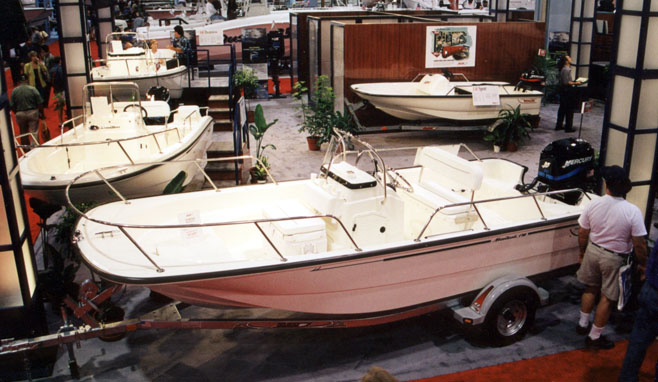 |
2002 Boston Whaler 170 Montauk
The new Montauk model shows many similarities
in its lines to the 13-Sport seen in the background.
The introductory price is an attractive $17,655,
as shown rigged with trailer and 90-HP Mercury
2-stoke Saltwater Series engine.
PhotoCredit: Jeff Angeleri - Scan: JWH |
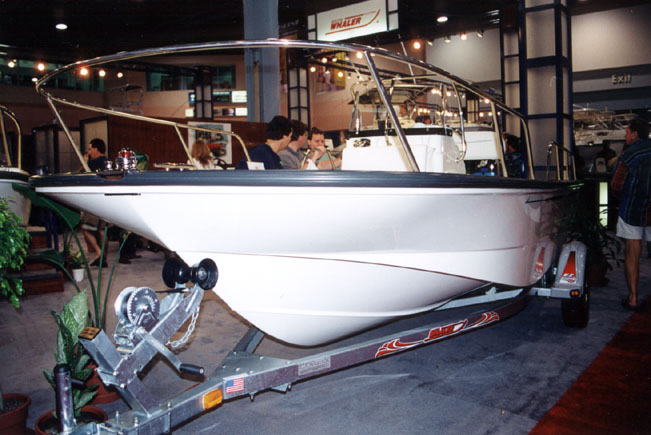 |
Vestigial Smirk
The bow of the new hull includes just enough of
a suggestion of a smirk to pay homage to its lineage
as a Boston Whaler. The hull sides appear to be
slightly concave, with the chine line from the bow
forming a strong reverse chine as it slopes aftward.
Note also how well fitted to the trailer the boat's hull is.
The hull width just clears inside the fenders.
The bow navigation lamp fitting is a nice return
to "classic" style.
PhotoCredit: Jeff Angeleri - Scan: JWH |
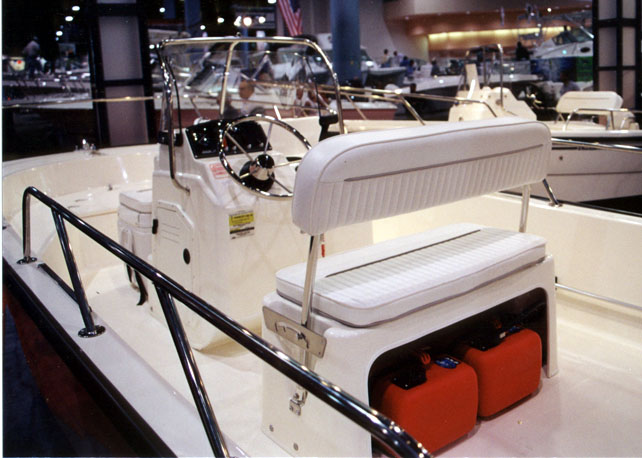 |
Center Console
The center console has a small windshield protected
with a wrap-around grab rail. The classic Reversible Pilot Seat
has been replaced with one with a molded base which encloses
the twin fuel tanks underneath. The seat back can be locked
in position.
PhotoCredit: Jeff Angeleri - Scan: JWH |
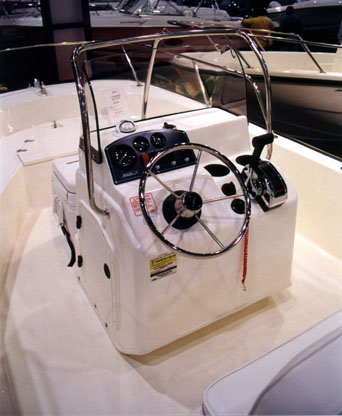 |
Center Console
The center console appears nicely laid out in this view,
although it is hard to judge the proportions. Not a great deal
of space is available for mounting electronic accessories.
PhotoCredit: Jeff Angeleri - Scan: JWH |
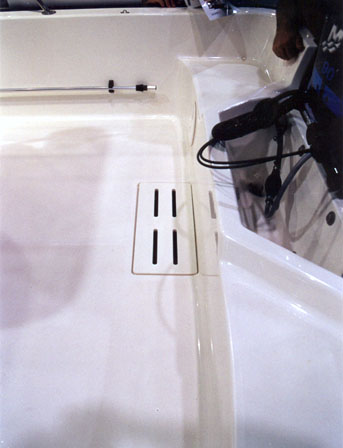 |
Rear Cockpit
Several new designs are seen here. The rounded corners
of the hull/transom now provide raised step pads. The bilge
sump is covered with a slotted lid. The engine well provides
an access tunnel to the console, concealing all the wiring and
control cables.
PhotoCredit: Jeff Angeleri - Scan: JWH |
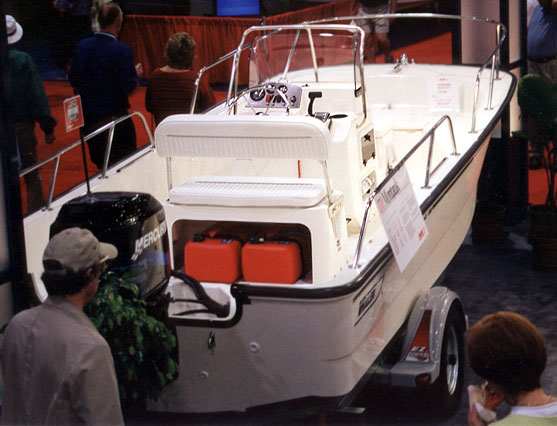 |
Stern Expression
At the stern the hull rounds to a soft vee,
although the specifications call for a deadrise of
16-degrees. It does not look like that here. The "granite"
color of the gauge instrument sub panel shows better here.
The drawer on the side of the console may be an optional
tackle drawer. Note the thru-hull drain on the transom
for the exhaust of the bilge sump pump. The tight fit
between the trailer fenders is evident. Use care when loading!
PhotoCredit: Jeff Angeleri - Scan: JWH |
More Information
Cetacea Page 58 shows more views of a recently delivered Montauk 170.
To Jeff Angeleri who
has provided me with the photographs of this new model I must
extend my most sincere thanks.
continuousWave --> Whaler --> Reference
DISCLAIMER: This information is believed to be accurate but there is no
guarantee. We do our best!
This article first appeared February 21, 2002.
Copyright © 2002 by James W. Hebert. All rights reserved.
Unauthorized reproduction prohibited.
This is a verified HTML 4.0 document served to you from continuousWave
URI: http://continuouswave.com
Last modified:
Author: James W. Hebert






